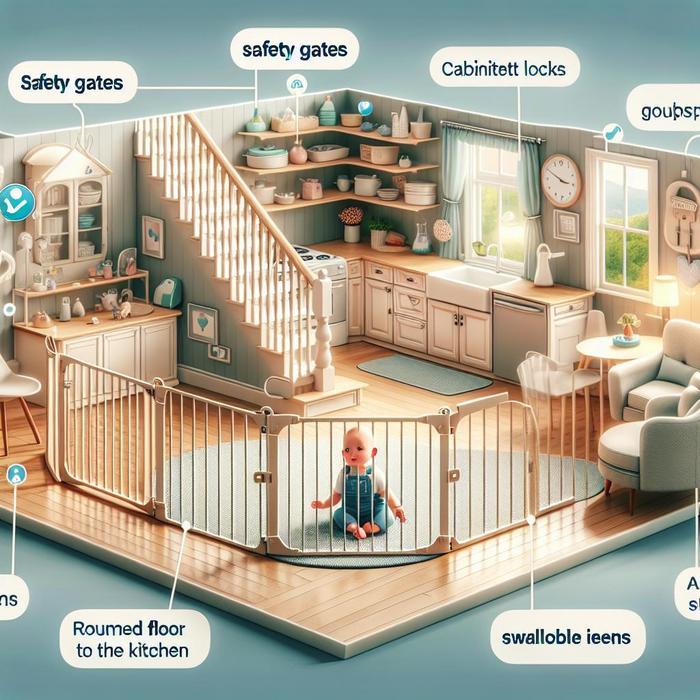Understanding the Importance of Childproofing Your Home
It’s a parent’s worst nightmare: your little one is crawling around the house, exploring their surroundings, and suddenly they trip over a loose rug or touch an open socket. The potential hazards around the household can be a constant cause of worry. This is precisely why childproofing your home is a critical step in ensuring baby safety at home.
When you start the childproofing process, you make sure that your home is a safe haven for your little one, regardless of their curiosity and vigor. Tackling this task may seem overwhelming, but this guide will help you navigate through it smoothly and effectively.
The Basics of Childproofing
Every room in your home has potential hazards for your baby. From sharp table corners to small objects that can be swallowed, it’s crucial to identify and mitigate these risks.
Here are some basic childproofing tips to get you started:
- Secure furniture and TVs to prevent tip-overs
- Use socket protectors on all outlets
- Install baby gates at both ends of stairs
- Keep small objects that can be swallowed out of reach
- Install corner protectors on sharp furniture edges
Remember, childproofing is not a one-time task. As your child grows and starts to walk and climb, new hazards will emerge. Continually reassess your home’s safety, and make adjustments as needed.
For more detailed information on childproofing basics, you can visit What to Expect and the National Safety Council.
Making Baby’s Play Area Safe
Now that we’ve covered some general childproofing tips let’s hone in on the area where your child will spend most of their time: the play area. This space should ideally stimulate your child’s development while also keeping them safe. To strike the right balance, consider the following tips:
- Use non-toxic, BPA free toys
- Ensure toys are age-appropriate and free of small parts that can be swallowed
- Childproof windows and cover electrical sockets
- Keep cords and blinds out of reach
- Secure furniture and appliances to prevent tip-overs
Remember, an essential part of childproofing is supervision. All the safety measures in the world cannot replace the watchful eyes of a parent.
If you want more guidance on creating a safe play area, you can visit Consumer Product Safety Commission and check out the Pampers’ guide on baby-proofing.
Further Steps in Baby Safety at Home
Alongside physical safety checks and changes, instilling safe habits is a crucial part of childproofing. This includes teaching your child about dangers, setting boundaries, and modeling safe behavior.
In the next part of this guide, we will delve more into these aspects, providing detailed advice to help you foster a safe and nurturing environment. After all, protecting your child goes beyond just childproofing your home—it’s also about imparting knowledge and encouraging safe practices.
Focusing on High-Risk Areas
Every space in your home needs attention in terms of childproofing but pay special attention to areas of high risk. For example, kitchens and bathrooms are two zones that often harbor many potential hazards.
- In the kitchen, secure all cabinets with childproof locks and move all cleaning supplies and sharp utensils to higher places.
- In the bathroom, use non-slip bath mats and install toilet locks to prevent accidental drowning.
For further detailed tips on childproofing these specific areas, you can visit “Guide to Childproofing Your Home” on the Cleveland Clinic.
Peace of Mind: Using Baby Monitors
Baby monitors are an important tool in ensuring your child’s safety when you’re not present in the room. These gadgets give you peace of mind by allowing you to keep an eye on your child while attending to other tasks. Modern baby monitors also come with features like alarms for unusual movements, heart rate monitors, and sensors for room temperature.
When choosing a baby monitor, opt for a model that satisfies your specific needs. For recommendations and reviews of the best baby monitors, you can check out this Reddit post by beyondthebump.
Controlled Access: Safety Gates
Safety gates are a must-have for preventing access to potentially dangerous parts of your home such as the kitchen, bathroom, and staircase.
- A tip to remember: the safety gate must be tall enough that a curious toddler cannot climb over it and robust enough that it won’t topple if your baby pushes against it.
- Ensure that the safety gate has a secure locking mechanism.
You can find quality safety gate suggestions on this Reddit post from the Parenting thread.
Staying Vigilant: Regular Safety Checks
Consistent and periodic safety checks are another essential part of childproofing. Regularly check toys, appliances, furniture, and every corner of your home for any new hazards that might have emerged. Do these safety checks at least once a month.
You can get a concise checklist for your safety checks at US News.
Minimizing Choking Hazards
Choking is a significant risk for babies and toddlers. Always be aware of this hazard and diligently check their environment, toys, and food to prevent any choking incidents.
- Remove all small objects that your child might put in their mouth.
- Avoid giving your child hard or large chunks of food.
- Always supervise mealtime and playtime.
Taking these steps and remaining vigilant can significantly reduce the risk of choking.
Fire Safety Measures
Fire safety is a crucial aspect of childproofing. Smoke alarms should be installed in all bedrooms and checked regularly to ensure they are working correctly. If possible, try to go for smoke alarms that are interconnected, so when one alarm goes off, all the others do too.
All members of the family should also be familiar with the fire escape plan. This will not only educate your child about fire safety but also prepare them for any unexpected situations.
While childproofing may seem like an intimidating task, remember that every step you take towards making your home safer is an investment in your child’s well-being and your peace of mind. We hope this guide has been helpful in your childproofing journey.

